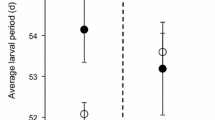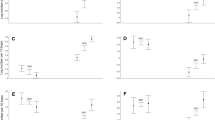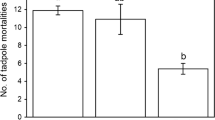Abstract
Predators can have important impacts on host–parasite dynamics. For many directly transmitted parasites, predators can reduce transmission by removing the most heavily infected individuals from the population. Less is known about how predators might influence parasite dynamics in systems where the parasite relies on vectors or multiple host species to complete their life cycles. Digenetic trematodes are parasitic flatworms with complex life cycles typically involving three host species. They are common parasites in freshwater systems containing aquatic snails, which serve as obligate first intermediate hosts, and multiple trematode species use amphibians as second intermediate hosts. We experimentally examined the impact of predatory salamanders (Ambystoma jeffersonianum) and trematode parasites (Echinostoma trivolvis and Ribeiroia ondatrae) on short-term survival of wood frog tadpoles (Rana sylvatica) in 150-L outdoor pools. Two trematode species were used in experiments because field surveys indicated the presence of both species at our primary study site. Parasites and predators both significantly reduced tadpole survival in outdoor pools; after 6 days, tadpole survival was reduced from 100% in control pools to a mean of 46% in pools containing just parasites and a mean of 49% in pools containing just predators. In pools containing both infected snails and predators, tadpole survival was further reduced to a mean of 5%, a clear risk-enhancement or synergism. These dramatic results suggest that predators may alter transmission dynamics of trematodes in natural systems, and that a complete understanding of host–parasite interactions requires studying these interactions within the ecological framework of community interactions.





Similar content being viewed by others
References
Alford R (1999) Ecology: resource use, competition, and predation. In: McDiarmid R, Altig R (eds) Tadpoles: the biology of anuran larvae. University of Chicago Press, Chicago, pp 240–278
American Veterinary Medical Association (2007) AVMA guidelines on euthanasia. Schaumburg, IL
Beaver PC (1937) Experimental studies on Echinostoma revolutum (Froelich), a fluke from birds and mammals. Biol Monogr 15:1–96
Belden LK (2006) Impact of eutrophication on wood frog, Rana sylvatica, tadpoles infected with Echinostoma trivolvis cercariae. Can J Zool 84:1315–1321
Belden LK, Kiesecker JM (2005) Glucocorticosteroid treatment of larval treefrogs (Hyla versicolor) increases infection by Alaria sp. trematode cercariae. J Parasitol 91:686–688
Belden LK, Rubbo MJ, Wingfield JC, Kiesecker JM (2007) Searching for the physiological mechanism of density-dependence: does corticosterone regulate tadpole responses to density? Physiol Biochem Zool 80:444–451
Benard MF (2004) Predator-induced phenotypic plasticity in organisms with complex life histories. Annu Rev Ecol Evol Syst 35:651–673
Billick I, Case TJ (1994) Higher-order interactions in ecological communities: what are they and how can they be detected. Ecology 75:1529–1543
Byers JE, Blakeslee AMH, Linder E, Cooper AB, Maguire TJ (2008) Controls of spatial variation in the prevalence of trematode parasites infecting a marine snail. Ecology 89:439–451
Decaestecker E, De Meester L, Ebert D (2002) In deep trouble: habitat selection constrained by multiple enemies in zooplankton. Proc Natl Acad Sci USA 99:5481–5485
Detwiler JT, Bos DH, Minchella DJ (2010) Revealing the secret lives of cryptic species: examining the phylogenetic relationships of Echinostome parasites in North America. Molec Phylogen Evol 55:611–620
Duffy MA, Hall SR, Tessier AJ, Huebner M (2005) Selective predators and their parasitized prey: are epidemics in zooplankton under top-down control? Limnol Oceanogr 50:412–420
Fraker ME et al (2009) Characterization of an alarm pheromone secreted by amphibian tadpoles that induces behavioral inhibition and suppression of the neuroendocrine stress axis. Horm Behav 55:520–529
Fredensborg BL, Mouritsen KN, Poulin R (2006) Relating bird host distribution and spatial heterogeneity in trematode infections in an intertidal snail—from small to large scale. Mar Biol 149:275–283
Fried B, Graczyk TK (2004) Recent advances in the biology of Echinostoma species in the “revolutum” group. Adv Parasitol 58:139–195
Fried B, Pane PL, Reddy A (1997) Experimental infection of Rana pipiens tadpoles with Echinostoma trivolvis cercariae. Parasitol Res 83:666–669
Gosner KL (1960) A simplified table for staging anuran embryos and larvae with notes on identification. Herpetologica 16:183–190
Griggs JL, Belden LK (2008) Effects of atrazine and metolachlor on the survivorship and infectivity of Echinostoma trivolvis trematode cercariae. Arch Environ Contam Toxicol 54:195–202
Hatcher MJ, Dick JTA, Dunn AM (2006) How parasites affect interactions between competitors and predators. Ecol Lett 9:1253–1271
Holland MP, Skelly DK, Kaskgarian M, Bolden SR, Harrison LM, Cappello M (2007) Echinostome infection in green frogs (Rana clamitans) is stage and age dependent. J Zool 271:455–462
Holt RD, Roy M (2007) Predation can increase the prevalence of infectious disease. Am Nat 169:690–699
Hsieh YH, Hsiao CK (2008) Predator–prey model with disease infection in both populations. Math Med Biol 25:247–266
Hudson PJ, Dobson AP, Newborn D (1992) Do parasites make prey vulnerable to predation? Red grouse and parasites. J Anim Ecol 61:681–692
Johnson PTJ, Sutherland DR (2003) Amphibian deformities and Ribeiroia infection: an emerging helminthiasis. Trends Parasitol 19:332–335
Johnson PTJ et al (2002) Parasite (Ribeiroia ondatrae) infection linked to amphibian malformations in the western United States. Ecol Monogr 72:151–168
Johnson PTJ, Sutherland DR, Kinsella JM, Lunde KB (2004) Review of the trematode genus Ribeiroia (Psilostomatidae): ecology, life history and pathogenesis with special emphasis on the amphibian malformation problem. Adv Parasitol 57:191–253
Johnson PTJ, Hartson RB, Larson DJ, Sutherland DR (2008) Diversity and disease: community structure drives parasite transmission and host fitness. Ecol Lett 11:1017–1026
Kaplan AT, Rebhal S, Lafferty KD, Kuris AM (2009) Small estuarine fishes feed on large trematode cercariae: lab and field investigations. J Parasitol 95:477–480
Keesing F, Holt RD, Ostfeld RS (2006) Effects of species diversity on disease risk. Ecol Lett 9:485–498
Kube J, Kube S, Dierschke V (2002) Spatial and temporal variations in the trematode component community of the mudsnail Hydrobia ventrosa in relation to the occurrence of waterfowl as definitive hosts. J Parasitol 88:1075–1086
Lafferty KD, Morris AK (1996) Altered behavior of parasitized killifish increases susceptibility to predation by bird final hosts. Ecology 77:1390–1397
Lefevre T, Lebarbenchon C, Gauthier-Clerc M, Misse D, Poulin R, Thomas F (2009) The ecological significance of manipulative parasites. Trends Ecol Evol 24:41–48
Lemly AD, Esch GW (1983) Differential survival of metacercariae of Uvulifer ambloplitis (Hughes, 1927) in juvenile Centrarchids. J Parasitol 69:746–749
Negovetich NJ, Esch GW (2007) Long-term analysis of Charlie’s Pond: fecundity and trematode communities of Helisoma anceps. J Parasitol 93:1311–1318
Packer C, Holt RD, Hudson PJ, Lafferty KD, Dobson A (2003) Keeping the herds healthy and alert: implications of predator control for infectious disease. Ecol Lett 6:797–802
Poulin R, Morand S (2004) Parasite biodiversity. Smithsonian Books, Washington
Prinz K, Kelly TC, O’Riordan RM, Culloty SC (2009) Non-host organisms affect transmission processes in two common trematode parasites of rocky shores. Mar Biol 156:2303–2311
Raffel TR, Hoverman JT, Halstead NT, Michel PJ, Rohr JR (2010) Parasitism in a community context: trait-mediated interactions with competition and predation. Ecology 91:1900–1907
Relyea RA (2007) Getting out alive: how predators affect the decision to metamorphose. Oecologia 152:389–400
Roy M, Holt RD (2008) Effects of predation on host-pathogen dynamics in SIR models. Theor Popul Biol 73:319–331
Roy HE, Pell JK (2000) Interactions between entomopathogenic fungi and other natural enemies: Implications for biological control. Biocontrol Sci Technol 10:737–752
Rutherford PL, Baker RL, Forbes MR (2007) Do larval damselflies make adaptive choices when exposed to both parasites and predators? Ethology 113:1073–1080
Schell SC (1985) Trematodes of North America. University of Idaho Press, Moscow
Scheuerlein A, Van’t Hof TJ, Gwinner E (2001) Predators as stressors? Physiological and reproductive consequences of predation risk in tropical stonechats (Saxicola torquata axillaris). Proc R Soc Lond B 268:1575–1582
Schotthoefer AM, Cole RA, Beasley VR (2003) Relationship of tadpole stage to location of Echinostome cercariae encystment and the consequences for tadpole survival. J Parasitol 89:475–482
Schotthoefer AM, Labak KM, Beasley VR (2007) Ribeiroia ondatrae cercariae are consumed by aquatic invertebrate predators. J Parasitol 93:1240–1243
Sheriff MJ, Krebs CJ, Boonstra R (2009) The sensitive hare: sublethal effects of predator stress on reproduction in snowshoe hares. J Anim Ecol 78:1249–1258
Smith CK, Petranka JW (1987) Prey size-distributions and size-specific foraging success of Ambystoma larvae. Oecologia 71:239–244
Stauffer JR Jr et al (2006) Schistosomiasis in Lake Malawi: relationship of fish and intermediate host density to prevalence of human infection. Ecohealth 3:22–27
Thiemann GW, Wassersug RJ (2000) Patterns and consequences of behavioral responses to predators and parasites in Rana tadpoles. Biol J Linn Soc 71:513–528
van Buskirk J, Smith DC (1991) Density-dependent population regulation in a salamander. Ecology 17:1747–1756
Vonesh JR, Osenberg CW (2003) Multi-predator effects across life-history stages: non-additivity of egg- and larval-stage predation in an African treefrog. Ecol Lett 6:503–508
Weissberger EJ (1999) Additive interactions between the moon snail Euspira heros and the sea star Asterias forbesi, two predators of the surfclam Spisula solidissima. Oecologia 119:461–466
Wootton JT (1994) Putting the pieces together: testing the independence of interactions among organisms. Ecology 75:1544–1551
Acknowledgments
We thank Nichole Field and Eric Tobin for assistance with the experiment. We also thank the reviewers, whose thoughtful comments greatly improved the manuscript. Alexa Class, Christinia Schoch, and J.M.W. contributed artwork to the illustration in Fig. 1. Research funding was provided by the Virginia Tech Department of Biological Sciences and the Virginia Tech Advance program, which was supported by National Science Foundation Grant SBE-0244916. J.M.W. was supported by a MAP grant and the College of Science and Technology at Radford University. During the writing of this manuscript, support was provided by National Science Foundation DEB-0918960 (Belden) and DEB-0918656 (Wojdak).
Author information
Authors and Affiliations
Corresponding author
Additional information
Communicated by Ross Alford.
Rights and permissions
About this article
Cite this article
Belden, L.K., Wojdak, J.M. The combined influence of trematode parasites and predatory salamanders on wood frog (Rana sylvatica) tadpoles. Oecologia 166, 1077–1086 (2011). https://doi.org/10.1007/s00442-011-1946-8
Received:
Accepted:
Published:
Issue Date:
DOI: https://doi.org/10.1007/s00442-011-1946-8




